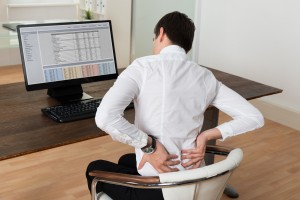

 Research has shown that accumulated bad posture can contribute to back pain and so it’s important that you maintain good posture in order to minimize back pain.
Research has shown that accumulated bad posture can contribute to back pain and so it’s important that you maintain good posture in order to minimize back pain.
Chronic pain affects millions of people and has now become a problem of epidemic proportions. People are suffering and searching for answers, but there doesn’t seem to be a definitive solution to resolving it.
Here are some tips to help you improve your posture so that you can put an end to back pain.
1. Keep Yourself Aligned
While seated, sit up straight and align the ears, shoulders, and hips in one vertical line. Any one position will end up becoming tiring. Be well aware of unbalanced postures such as crossing legs unevenly, leaning to one side and especially hunching over in any way.
2. Know Your Ergonomics
Be aware of your surroundings and switch them up accordingly. Watch for pain that goes away after switching positions; sudden back pain that is experienced with a new job, or a new office chair, or a new car; and/or back pain that comes and goes for months.
3. Don’t Overcompensate
Relax! Avoid restricting movements. For individuals who already have some back pain, it is a natural tendency to try to limit movements to avoid the potential pain associated with your movements. However, unless there is a serious problem, the spine is designed for movement and any limitation in motion over a long period of time creates more pain and a downward cycle of less motion (equaling more pain!)
4. Use Props
Ergonomic ‘props’ can help to take the strain off of the spine. Use office chairs with adjustable back support. Elevated footrests, portable lumbar back supports, or even a towel or small pillow can be used while sitting in an office chair. Using backpacks that are designed to minimize back strain can also influence proper posture.
5. Exercise Regularly
Walking, swimming, or cycling keeps your body conditioned. These activities will promote good posture, which will, in turn, further help to condition muscles and prevent injury. Balancing your core strength and back muscles so that they are stronger than your abdominal muscles is essential to help support the upper body and maintain good posture.
6. Supportive Footwear
Avoid wearing shoes with too high of heels, which can affect the body’s center of gravity and change the alignment of the whole body, which in turn will affect back support and posture. When standing for long periods of time, placing a rubber mat on the floor can improve comfort.
7. Ergonomics in Motion
Simple tasks such as walking, lifting and even holding a telephone, are activities that require attention to posture. It is important to maintain good posture even while moving to avoid injury. Back injuries are especially common due to awkward, sudden movements.
8. Keep on Moving
Slouching, slumping, and other poor postures become more likely when you remain still. This in turn puts extra pressure on the neck and back. In order to maintain a relaxed yet supported posture, change positions regularly. Take a break from sitting in an office chair every half hour for two minutes in order to stretch, stand, or walk.
Dormant butt syndrome (DBS), weak gluteal muscles, raises chronic knee, hip, and back pain risk
Dormant butt syndrome (DBS) – weak gluteal muscles – raises chronic knee, hip, and back pain risk. Knee, hip, and back pain is a growing problem in Americans, and researchers suggest many of these incidences have to do with what is known as dormant butt syndrome. Continue reading…
Lower back pain may be ankylosing spondylitis, a type of spinal arthritis
Lower back pain may be a sign of ankylosing spondylitis (AS), a type of spinal arthritis. Ankylosing spondylitis is a type of arthritis in the spine, so it is not caused by injury to the spine but rather inflammation in the vertebrae. Continue reading…
Copyright © www.orthopaedics.win Bone Health All Rights Reserved